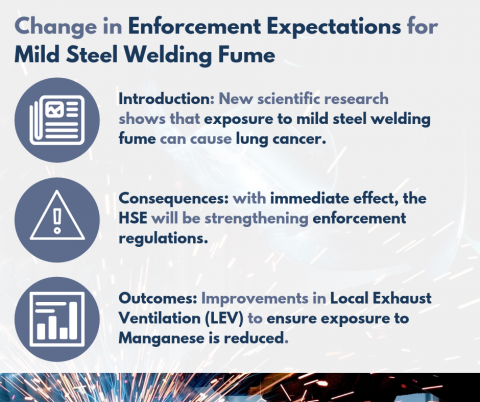WA Management provides professional, adaptable and appropriate solutions for your Health and Safety needs. Our research blog takes a detailed look at particularly topical areas of the sector, or risks that are repeatedly overlooked. This week, to tie in with the with our ‘Hazard of the Month’ for March, we take a look at the hazards associated with fumes, and how you can mitigate the risks for you and your employees
Fumes – an important hazard
Whilst a huge range of Health and Safety challenges are all too identifiable in our day-to-day lives, many can slip seamlessly under the radar. One such hazard is that of fumes, broadly-defined to mean a vaporous substance that can be released into the air and cause damage to humans if inhaled. Upon greater scrutiny, we can see that such substances are everywhere in our lives: the deodorant we use in our morning routine, the pollution we emit as we travel to work, and even the gases we use to cook our dinners.
 However, the relevance of Fumes as a danger gained a more specific hazard earlier this year, when the HSE reclassified Mild Steel Welding Fume as carcinogenic – essentially meaning that sustained inhalation of the substance could result in life-altering or even fatal diseases. The re-assessment of this substance was advanced by the International Agency for Research on Cancer; and has since been wholly endorsed by the Workplace Health Expert Committee and HSE.
However, the relevance of Fumes as a danger gained a more specific hazard earlier this year, when the HSE reclassified Mild Steel Welding Fume as carcinogenic – essentially meaning that sustained inhalation of the substance could result in life-altering or even fatal diseases. The re-assessment of this substance was advanced by the International Agency for Research on Cancer; and has since been wholly endorsed by the Workplace Health Expert Committee and HSE.
Whilst all this seems somewhat abstract and full of jargon, the relevance of it is highly important. Fortunately, WA Management is here to break down some of the main risks and explore the many ways in which they can be mitigated.
Mild Steel Welding Fume – What has the HSE said?
As mentioned above, the HSE has fully accepted research that Mild Steel Welding Fume can cause life-altering illnesses such as:
- Lung Cancer
- Neurological issues that relate to Parkison’s Disease
- Possible links to kidney cancer
This fits in to a broader attempt by the HSE to re-assess the dangers associated with a wide range of vaporous substances, and the usefulness of general ventilation in preventing their inhalation. Rather worryingly, a recent bulletin preliminarily indicated that many forms of ventilation, long considered sufficient, were not actually doing enough to protect employees exposed to fumes.
This all seems rather bleak – what can be done?
 Fortunately, the HSE has issued comprehensive new enforcement expectations outlining the new responsibilities that employers face. Equally, the suggest ways in which individual welders can look after their own safety, further encouraging al employees to engage with Health and Safety policies. The risk mitigation strategies demanded centred around the implementation of better Local Exhaust Ventilation (LEV), and the use of Respiratory Protection Equipment (RPE).
Fortunately, the HSE has issued comprehensive new enforcement expectations outlining the new responsibilities that employers face. Equally, the suggest ways in which individual welders can look after their own safety, further encouraging al employees to engage with Health and Safety policies. The risk mitigation strategies demanded centred around the implementation of better Local Exhaust Ventilation (LEV), and the use of Respiratory Protection Equipment (RPE).
These can be summarised as the following steps.
- Suitable and well-maintained LEV should be in place to prevent exposure to the carcinogenic fumes.
- Good practices of work should be observed, such as limiting welding time or working in a suitable place outdoors.
- Even if the above engineering controls are in place, employees should look to use the appropriate RPE.
- Constantly re-visit these measures to ensure they are well maintained and up to standard.
- Amend Risk Assessments to reflect all this and communicate new policies to those at risk.
Check out our handy summary below for a visual depiction of this.

Conclusions – how WA Management can help
As mentioned, all this new information regarding the dangers of welding fumes can be at once frightening and overwhelming. Obviously the HSE, like all employers and employees, only issues advice designed to keep workers safe. Whilst the enforcement expectations outlined above are now in place, it can understandably take businesses time to adapt to the new changes and their relevance.
Here at WA Management, we seek to comprehensively, but accessibly, convey Health and Safety information. We work closely with our clients to provide a tailored service which delivers results. If any of the issues raised in this research blog are new to you, or you feel require clarification, contact us HERE today for a free consultation and quotation. Whilst many risks today can be confusing and murky, solving them definitely does not have to be.
Contact WA Management HERE for more
Or read the original HSE enforcement expectations, which came into force at the end of February HERE
